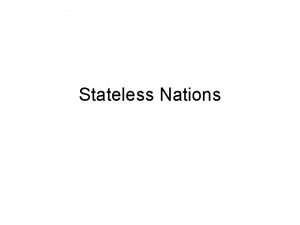Multistate modeling and simulation of patient trajectories after

- Slides: 1

Multi-state modeling and simulation of patient trajectories after allogeneic hematopoietic stem cell transplantation to inform drug development David James, Jennifer Ng, Jiawei Wei, and Marc Vandemeulebroecke Biostatistical Sciences and Pharmacometrics, Novartis Table 1. Final transition-specific baseline covariate model (HR: hazard ratio) Executive summary § Two essential pieces of information were missing for planning a randomized clinical study to assess the safety and efficacy of a new drug in the prevention of graft versus host disease (Gv. HD). § Lack of in-house patient-level data was addressed by licensing a subset of the CIBMTR (Center for International Bone Marrow Transplant Research) database. § Lack of drug efficacy data was indirectly addressed through multi-state modeling and simulations to investigate putative drug effects. • Simulations provided the basis for evaluating the operating characteristics of the planned study. Objectives To characterize patient trajectories through states of disease after allogeneic hematopoietic stem cell transplantation (allo-HSCT), quantifying the transition rates into various event states and identifying patient characteristics associated with differential transition rates. This modeling and simulation activity was conducted to investigate drug development scenarios for the prevention of Graft-versus-Host-Disease (Gv. HD) after allo-HSCT. Methods Multi-state models were built on data from the Center for International Blood and Marrow Transplant Research (CIBMTR [4]), a prime data source on stem cell transplantation in the US. Target population: • Age between 18 and 75 years. • Allogeneic peripheral blood tissue transplanted between 2009 and 2013. • Acute myeloid leukemia (AML), acute lymphoblastic lymphoma (ALL), or non. Hodgkin lymphoma (NHL). • Fully matched related donors (MRD) or unrelated donors (MUD). • Use of cyclosporin A or tacrolimus with methotrexate (MTX) as prophylaxis of Gv. HD. • Patients using alemtuzumab (Campath) were excluded. Five states of interest: • Initial (event-free), acute Gv. HD grade 3 or 4 (a. Gv. HD), severe chronic Gv. HD (c. Gv. HD), relapse, and death. Multi-state models: Five time-continuous, finite-state Markovian candidate models. Transition probabilities were estimated using the Aalen-Johansen estimator [1]. Ten candidate baseline covariates were considered (age, sex, donor type, prophylaxis, disease, etc. ). Selection of a final model was based on stepwise covariate selection, goodness-of-fit diagnostics, and clinical relevance. Multi-state simulations: Trial scenarios were simulated based on the final model and assuming various putative drug effects on top of the background transition hazards to quantify 4 composite endpoints of interest. Computations were conducted using the R language [2, 3, 5 -7]. Transition 1 Initial->a. Gv. HD 2 Inital ->c. Gv. HD 3 Initial->Relapse 4 Initial -> Death 9 c. Gv. HD->Death Covariate HR 95% CI Donor (MUD vs MRD) 1. 91 1. 38 – 2. 64 Disease (ALL vs AML) 1. 87 1. 30 – 2. 68 Year (2013 vs 2009) 0. 54 0. 34 – 0. 85 Year (2013 vs 2009) 0. 43 0. 22 - 084 Karnofsky (<90 vs >=90) 1. 53 1. 19 – 1. 97 Karnofsky (<90 vs >=90) 1. 78 1. 12 – 2. 83 Year (2013 vs 2009) 4. 11 1. 72 – 9. 79 Fungal infection 2. 13 1. 02 – 4. 45 Candidate covariates, fitted in a transition-specific manner: • Age, sex, TX year. • Disease: AML, ALL, NHL. • Donor type: MUD, MRD. • Conditioning : tacrolimus or cyclosporine with MTX. • Karnofsky: <90 vs ≥ 90. • Patient/donor CMV (cytomegalovirus) status. • Fungal infection prior to TX. • Novartis-defined risk score (Low, Medium or High). • MUD patients have higher relative risk (about double) than MRD patients of transitioning from the initial state into a. Gv. HD. • Patients with ALL disease have higher relative risk (~90%) than AML patients of transitioning from the initial state to a. Gv. DH. • Patients with <90% Karnofsky score have higher risks of transitioning from the initial state to relapse or death (~50% and ~80%, respectively). • Patients transplanted in 2013 have lower risks for transitions 1, 2; higher for 9. • Patients who experienced a clinically significant fungal infection prior to transplantation have a higher risk of transitioning from c. Gv. HD to Death. • None of the covariates explored are associated with transitions 5, 6, 7, 8 or 10. Results (2): Clinical trial simulations Simulations from this model allowed to compare the operating characteristics of a future clinical trial with two arms (active vs. placebo), assuming the investigational drug reduces selected transition rates to a specified extent, and to compare the trial’s power among 4 composite endpoints with various sample sizes. Simulation scenarios: • Nine trial scenarios were simulated 400 times. Each scenario represents a sample size N (120, 160, 220 per arm) and a transition rate reduction D ( -10%, -20%, -30%) on the 4 transitions Initial a. Gv. HD, Initial Relapse, a. Gv. HD Relapse, and Relapse Death. • Four endpoints were assessed: overall survival (OS), Gv. HD-free survival (GFS), Gv. HD-/relapse-free survival (GRFS), progression-free survival (PFS). State probability estimates under one scenario (N=220, D=-30%) based on 400 simulated trials Power for 4 clinical endpoints for a drug effect of D =-30% Conclusions Multi-state models provide a rich framework for exploring complex progressive conditions such as the patient journey after allo-HSCT. Selected model The CIBMTR database allowed to estimate transition probabilities into relevant clinical states under the current standard of care in the target population. Simulations provided a means to investigate putative drug effects of various degrees on some transition probabilities, as per the drug’s mechanism of action. Among the 4 clinical endpoints, Gv. HD-free survival was found to have highest power to detect drug effects. Acknowledgements We would like to thank Novartis’ Real-World Evidence Center of Excellence for facilitating the access to CIBMTR data. Results (1): multistate modeling A final 5 -state, 10 -transition model was selected. It included 5 baseline covariates (donor type, disease, Karnofsky group, year of transplant (Tx), and fungal infection) affecting 5 transition rates (Init. a. Gv. HD, Init. c. Gv. HD, Init. Relapse, Init. Death, Relapse Death). See Table 1. Transition probabilities were estimated for target patients, e. g. , at 12 months, acute myeloid leukemia recipients of matched related donor allo-HSCT were estimated to have transition probabilities 0. 024, 0. 039, 0. 100 and 0. 227, from the initial state to a. Gv. HD, c. Gv. HD, relapse and death, respectively. References [1] Aalen OO, Johansen S (1978). An empirical transition matrix for non-homogeneous Markov chains based on censored observations. Scandinavian Journal of Statistics. Jan 1: 141 -50. [2] Carstensen B, Plummer M, Laara E, Hills M (2016). Epi: A Package for Statistical Analysis in Epidemiology. R package version 2. 0. http: //CRAN. R-project. org/package=Epi. [3] Carstensen B, Plummer M (2011). Using Lexis objects for multi-state models in R. Journal of Statistical Software. Jan 4; 38(6): 1 -8. [4] Center for International Blood and Marrow Transplant Research. CIBMTR [Internet] 2016. [accessed 10 February 2017]. URL https: //www. cibmtr. org/pages/index. aspx [5] De Wreede LC, Fiocco M, Putter H (2010). The mstate package for estimation and prediction in non- and semi-parametric multi-state and competing risks models. Computer methods and programs in biomedicine, 99(3), pp. 261 -274. [6] R Core Team (2015). R: A language and environment for statistical computing. R Foundation for Statistical Computing, Vienna, Austria. URL https: //www. R-project. org/. [7] Therneau TM (2015). Survival: Survival Analysis. http: //CRAN. R-project. org/package=survival.

